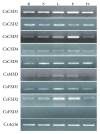Genome-Wide Identification and Transcriptional Expression Analysis of Cucumber Superoxide Dismutase (SOD) Family in Response to Various Abiotic Stresses
- PMID: 28808654
- PMCID: PMC5541821
- DOI: 10.1155/2017/7243973
Genome-Wide Identification and Transcriptional Expression Analysis of Cucumber Superoxide Dismutase (SOD) Family in Response to Various Abiotic Stresses
Abstract
Superoxide dismutase (SOD) proteins are widely present in the plant kingdom and play important roles in different biological processes. However, little is known about the SOD genes in cucumber. In this study, night SOD genes were identified from cucumber (Cucumis sativus) using bioinformatics-based methods, including 5 Cu/ZnSODs, 3 FeSODs, and 1 MnSOD. Gene structure and motif analysis indicated that most of the SOD genes have relatively conserved exon/intron arrangement and motif composition. Phylogenetic analyses with SODs from cucumber and several other species revealed that these SOD proteins can be traced back to two ancestral SODs before the divergence of monocot and dicot plants. Many cis-elements related to stress responses and plant hormones were found in the promoter sequence of each CsSOD gene. Gene expression analysis revealed that most of the CsSOD genes are expressed in almost all the tested tissues. qRT-PCR analysis of 8 selected CsSOD genes showed that these genes could respond to heat, cold, osmotic, and salt stresses. Our results provide a basis for further functional research on SOD gene family in cucumber and facilitate their potential applications in the genetic improvement of cucumber.
Figures







References
-
- Yan J. J., Zhang L., Wang R. Q., et al. The sequence characteristics and expression models reveal superoxide dismutase involved in cold response and fruiting body development in Volvariella volvacea. International Journal of Molecular Sciences. 2016;17:34–46. doi: 10.3390/ijms17010034. - DOI - PMC - PubMed
LinkOut - more resources
Full Text Sources
Other Literature Sources

